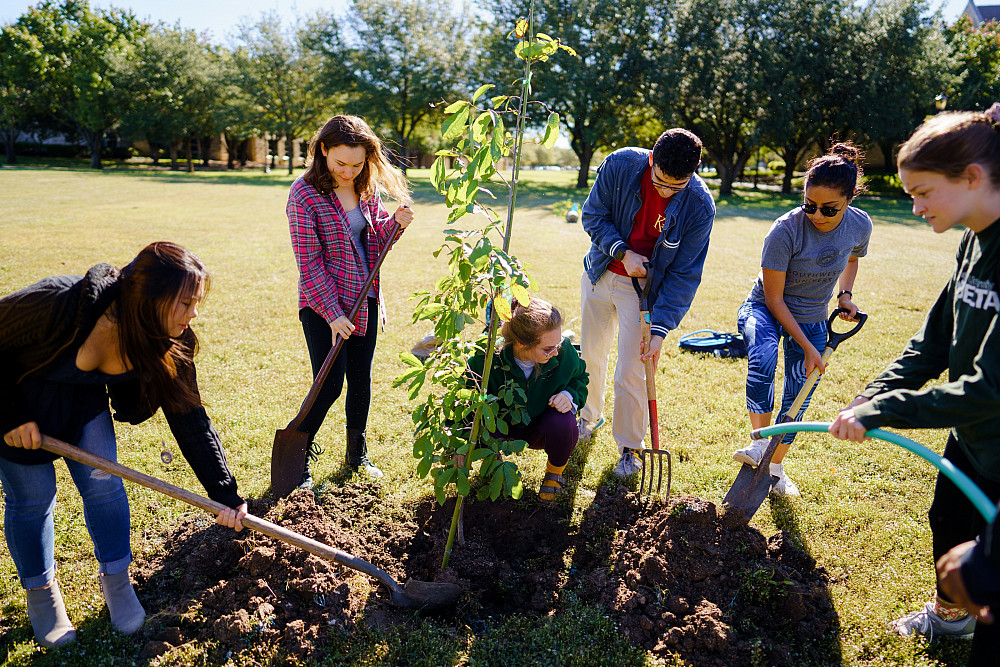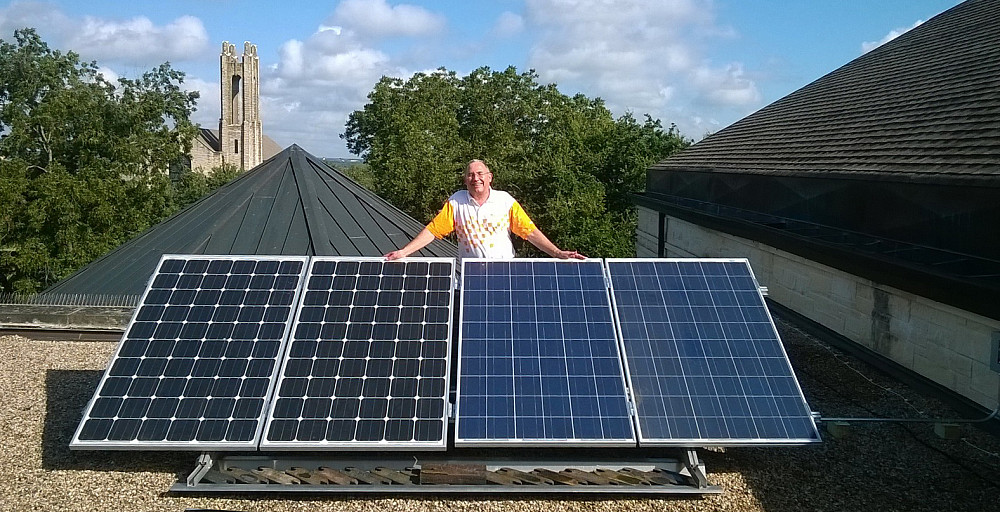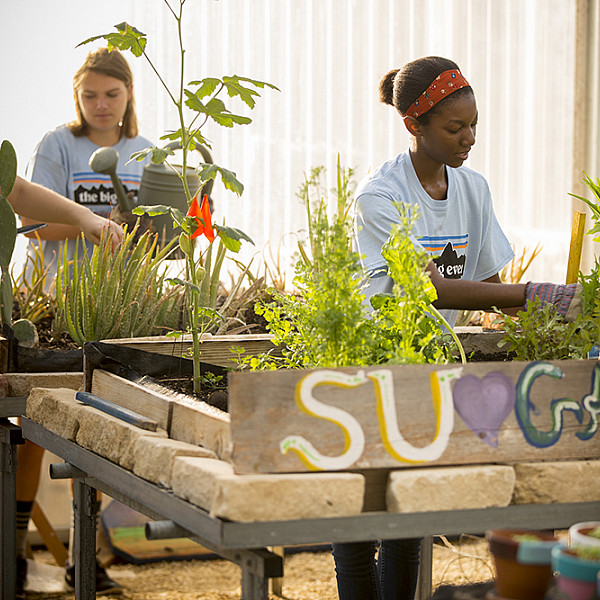News
In Good Company: Building a Climate of Sustainability at SU
March 24, 2020
March 24, 2020
A group effort for change
In the fall of 2018, for their capstone project, six Southwestern students compiled a 50-year history of activism at the University. As environmental studies majors, they aimed to investigate how various forms of activism contribute to the sustainability of a campus in all its parts, from carbon footprint to social climate. While their manuscript focused on the unique role of students as campus changemakers—environmentally as well as in other realms of sustainability—the authors concluded their report with the following observation: “It must be acknowledged that the past two decades of … sustainability initiatives were made possible by the efforts of earlier student activists, with the support of faculty and staff members.”
Those last few words, “with the support of faculty and staff members,” highlight the often-overlooked truth that has earned Southwestern its place as one the greenest schools in Texas. While there is no doubt that students have been and continue to be instrumental in bringing sustainability initiatives to campus, student labor alone is not enough to keep them going. Time, as always, is a major limiting factor: most students will only spend four years on campus, and that time is largely consumed by academics, internships, and extracurriculars. For those who do find the time, a lack of financial and experiential clout make it difficult to build a compelling case for change. As a result, those sustainability efforts that get off the ground are often not sustainable themselves, and many have sputtered out over the years.
Who, then, is helping students keep sustainability alive on campus? Those with a vested interest in the welfare of the campus community: faculty and staff. Faculty and staff have supported student activism and sustainability initiatives from the beginning, and many have been directly involved in those initiatives and even spearheaded their own. Early recycling efforts on campus were student driven with support from the Facilities Management department, which later absorbed the responsibility when recycling on campus grew. When the SU garden was established in 2008, it was a joint effort among students, faculty, and staff. When Southwestern became the first Texas school (and 16th in the nation) to switch to renewable electricity in 2010, students led the charge, but faculty and staff provided much of the legwork and expertise. And in 2017, Southwestern faculty set a national example of commitment to sustainability by calling upon the U.S. Congress to take action on climate change.
Laura Hobgood, professor of religion, frequent cochair of the Environmental Studies Department, and advisor for Students for Environmental Activism and Knowledge (SEAK) since its founding in 1999, describes the serendipitous circumstances that put sustainability at the forefront of campus conversation when she arrived at Southwestern in 1998: “It just … was good timing, where we had the associate vice president for the Physical Plant [the previous title of Facilities Management], the president, and students and faculty sort of all [working] together to get a lot of the green stuff done.” Picking foster dog hair off her black sweater, Hobgood recounts sustainability milestones on campus: the introduction of the environmental studies program in 2000, the institution of the Green Fund in 2015 (a student-supported fund for sustainability projects on campus), and Georgetown’s shift to renewable electricity in 2017 (following Southwestern’s example). As she speaks of the past, she looks up alumni and old colleagues on Facebook, curious where they ended up. This person picked up recycling in their truck every week; they still live in Austin. That one helped found the garden and is now an environmental lawyer. This one cofounded SEAK and now works in sustainable development in San Francisco.
As [Hobgood] speaks of the past, she looks up alumni and old colleagues on Facebook, curious where they ended up. This person picked up recycling in their truck every week; they still live in Austin. That one helped found the garden and is now an environmental lawyer. This one cofounded SEAK and now works in sustainable development in San Francisco.
“There was a real willingness to have … student–faculty and staff–administration collaboration,” Hobgood says of the early years of campus sustainability efforts. “None of these things could’ve happened without that entire collaboration happening. But they also wouldn’t necessarily have happened at all without the student push for those things.”

Southwestern: Providing an opportunity to change the world
Why did students push? Joshua Long, chair of the Environmental Studies Department, has some theories. Recalling his arrival at Southwestern in 2011, Long says, “I picked up really quick that this was a place where students cared about a range of issues and were just beginning to speak more broadly about the intersectionality of activist issues, which was something that I had not seen on other campuses.”
Long cites Southwestern’s core values (among them “encouraging activism in the pursuit of justice and the common good”) and close campus community as possible reasons for this, as well as the interdisciplinarity of academic programs. “[T]he interdisciplinarity of the way we teach allows us to gain access to issues of injustice that we wouldn’t otherwise have access to,” says Long. This, in turn, creates greater solidarity among the campus community. “I think … we often get siloed in our departments on university campuses,” Long observes. “We just sit there and we think, … ‘Oh, it’s the environment we have to worry about, not any of this other stuff,’ when really they’re all very much linked.”
“There are a lot of students out there who want to find a campus where they can get involved. They don’t just want to get a degree; they don’t just wasn’t to take classes. They feel a strong need to change the world. And Southwestern, I think, gives them that opportunity.” —Joshua Long, associate professor of environmental studies
In discussing how this activist community at Southwestern empowers students, Long takes a broad perspective. “There are several students who [are] growing up in the era of climate change, [and] they’re seeing a lot of issues around them, whether it be around migration and immigration, climate change, racism … . Everything from Black Lives Matter to #MeToo is really important right now and becoming more visible and accessible as a movement,” he explains. “There are a lot of students out there who want to find a campus where they can get involved. They don’t just want to get a degree; they don’t just wasn’t to take classes. They feel a strong need to change the world. And Southwestern, I think, gives them that opportunity.”
Student-led recycling efforts
John Dixon, who has worked at Southwestern since 1998, agrees. Dixon is the recycling man on campus; most mornings, you can see him driving his golf cart down Southwestern Boulevard, blue recycling cans in tow. As Dixon can attest, the close campus community at Southwestern has enabled a mindset of sustainability to spread outside of the classroom, reaching every corner of campus. Asked when he became aware of environmental concerns, Dixon says it was the early student-led recycling efforts at SU that clued him in. “That’s when I started to be more aware and kind of take ownership of what I was doing and try to help push our expectations forward,” he shares. “I didn’t not not care before; it’s just not something that I felt was as important. Now I see that there’s a reason for it. There’s just a lot more skin in the game now.”
Working with recycling, Dixon says that most of his struggles come not from opposition but, ironically, from lack of knowledge. “There’s not been a whole lot of resistance,” he says. “There’s just been a lot of people who forget that there’s things that need to be done.”

Sustainability at SU, 1970–2020 and beyond
Facilities, where Dixon works, is striving to overcome this lack of awareness, though not without help. In 2019, after years of lobbying by students and faculty, Southwestern hired Sustainability Coordinator Veronica Johnson to help keep sustainability projects going after students graduate, to spread awareness of sustainable practices on campus, and—most importantly—to serve as a liaison between Facilities, students, and faculty. Because Facilities is the most knowledgeable about the physical sustainability of campus, their buy-in is crucial to the success of most student sustainability initiatives. As Hobgood observes, “A lot of the sustainability on campus does have to do with the Physical Plant.” Working within Facilities, Johnson is able to share this institutional knowledge with students and faculty so that their sustainability efforts will have the greatest chance of success.
Since her arrival at SU, Johnson has worked with students to conduct a waste audit, launch an on-campus exchange store, install bat houses by the garden, implement a recycling education program, and much more. Chief among her initiatives is an EcoRep program, which provides sustainability-minded students a chance to be paid for their work improving campus.
While financial constraints often limit what Johnson and Facilities can do, with help from devoted students and faculty, sustainability has continued to grow on campus since Southwestern’s first Earth Day in 1970. The environmental studies major began when faculty members agreed to teach the necessary classes pro bono, in addition to their regular course loads. Since its founding, the SU Community Garden has been tended by the committed members of the Garden Club, who volunteer their time to promote sustainable food cultivation on campus. And when spending can’t be avoided, as Hobgood explains, “it’s just trying to work with the administration such that the green things won’t … have a negative impact on the budget. Because budgets are always nip and tuck, budgets are always tight … [a]nd that’s why … financial sustainability is part of environmental sustainability.” On the other hand, tight budgets have been the impetus for many sustainability initiatives as well, such as Facilities’ recent decision to replace 202 high-pressure sodium light bulbs with LED fixtures. The new bulbs will pay for themselves in just under four years, demonstrating that sustainability initiatives can be successful not in spite of their cost but because of it.

Southwestern replaced all 202 old street lights with new sustainable LED street light fixtures. Each new LED fixture uses only 196 watts of power, compared with the 423 watts required for each current high-pressure sodium fixture. The new lights will be more cost effective, require less maintenance, have longer lifespans, and provide better color visibility at night than the old fixtures.
This began as a story about student-led sustainability initiatives at Southwestern. However, the more you learn of Southwestern’s history of sustainability, the less relevant divisions of student, faculty, and staff seem. It becomes clear that nothing on SU’s campus is accomplished alone, especially when it comes to sustainability. Every time you recycle a plastic bottle, walk by the garden, or turn on a light, you tap into a network of dedicated people, past and present, who have worked hard to make Southwestern a better place for everyone. Like many other campuses, Southwestern still has a long way to go before it can claim to be truly sustainable, but it is important to remember that the quickest way there is together. At the end of the day, sustainability isn’t about camping alone in the wilderness; it’s about working together to accomplish what can’t be done alone. And at Southwestern, you’re in good company.





















